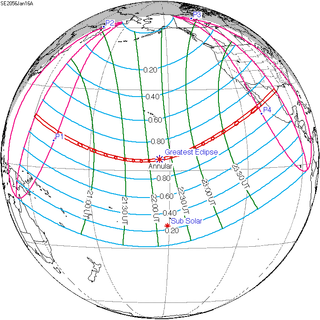| Solar eclipse of January 16, 2056 | |
|---|---|
| Type of eclipse | |
| Nature | Annular |
| Gamma | 0.4199 |
| Magnitude | 0.9759 |
| Maximum eclipse | |
| Duration | 172 s (2 min 52 s) |
| Coordinates | 3°54′N 153°30′W / 3.9°N 153.5°W |
| Max. width of band | 95 km (59 mi) |
| Times (UTC) | |
| Greatest eclipse | 22:16:45 |
| References | |
| Saros | 132 (48 of 71) |
| Catalog # (SE5000) | 9632 |
An annular solar eclipse will occur at the Moon's descending node of orbit between Sunday, January 16 and Monday, January 17, 2056,[1] with a magnitude of 0.9759. A solar eclipse occurs when the Moon passes between Earth and the Sun, thereby totally or partly obscuring the image of the Sun for a viewer on Earth. An annular solar eclipse occurs when the Moon's apparent diameter is smaller than the Sun's, blocking most of the Sun's light and causing the Sun to look like an annulus (ring). An annular eclipse appears as a partial eclipse over a region of the Earth thousands of kilometres wide. The Moon's apparent diameter will be near the average diameter because it will occur 6.25 days after perigee (on January 10, 2056, at 16:50 UTC) and 7.2 days before apogee (on January 24, 2056, at 2:20 UTC).[2]
The path of annularity will be visible from parts of the Marshall Islands, northern Mexico, and Texas. A partial solar eclipse will also be visible for parts of Oceania, Hawaii, western and central North America, and Central America.
- ^ "January 16–17, 2056 Annular Solar Eclipse". timeanddate. Retrieved 16 August 2024.
- ^ "Moon Distances for London, United Kingdom, England". timeanddate. Retrieved 16 August 2024.
